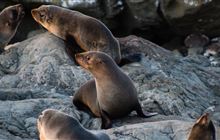Leave seals alone - they're just resting
Archived content: This media release was accurate on the date of publication.
Introduction
DOC is reminding the public to leave seals alone to rest at this time of year.Date: 19 July 2017
East Coast Operations Manager John Lucas says he is concerned about reports of an incident last week where a group of people with a dog chased a seal near Midway Beach, Gisborne.
Seals are protected under the Marine Mammals Protection Act and this sort of harassment is unacceptable.
“This could have also resulted in a severe injury and it is a timely reminder that seals are wild animals, so don’t get too close.”
“I must stress to keep at a distance of at least 20 metres and ensure dogs are on a leash”, he said.
“It is not unusual for seals to be seen at this time of the year. In the coming months between August to November newly-weaned fur seal pups and juveniles come ashore, but it’s just a resting up period for them before they head out to sea again in search of food.”
“The seals may look distressed and scrawny and display signs of sneezing, coughing and may have weepy eyes, but that’s just natural for them and they really don’t need any human intervention. They will return to the water and swim away when they are rested and ready to go.”
John says while seals may look harmless and helpless they are wild animals and will defend themselves if they feel threatened. They can carry infectious diseases and can cause serious injuries.
DOC has a hands-off policy with seals and will only intervene if a seal is obviously severely injured, is entangled in marine debris or is in a dangerous place such as on or near a public road. In that case, people could call the 24-hour hotline 0800 DOC HOT (0800 362 468).
If you encounter a seal on or near a beach please leave it to rest:
- Always keep dogs on a leash, under control and away from seals
- Ensure you keep small children at a safe distance and under your control when watching seals
- Avoid getting closer than 20 metres
- Do not get between the seal and the sea
- Do not touch or feed the seal
Background information
New Zealand fur seals once lived and bred right round the coast of New Zealand. But they were hunted for more than 700 years, first by Maori and then from the 1790s by European sealers.
An estimated two million New Zealand fur seal were clubbed to death in the early 1800s to make fur seal hats and coats.Oil from their bodies was also burned in lamps for lighting.
By the 1830s, the New Zealand fur seal was close to extinction. Sealing was finally banned in 1894. Since then their numbers have been rising and gradually fur seals have been re-colonising our coastline.
In 1991, almost 100 years after sealing was banned, New Zealand fur seals began breeding again at Cape Palliser, at the very bottom of the North Island. Since then fur seals have also been gradually recolonising the North Island coast.
Contact
Jamie Quirk, Ranger Biodiversity, Gisborne
Phone: +64 6 869 0460
Mobile: +64 27 432 4920
Email: jquirk@doc.govt.nz

